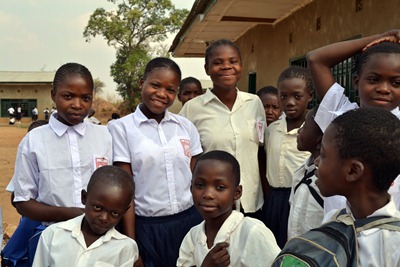Visit any one of the five primary schools near MMG’s Kinsevere mine in the Democratic Republic of Congo (DRC) and you’ll find classrooms of boys and girls eager to learn.
However, not too long ago, it was unusual for girls from the 26 villages near the mine to attend school.
There were practical as well as cultural reasons for this.
Social Development Manager Michel Santos explains that “some parents felt that the distance between home and school was too far for a girl to walk safely.
“Others believed that education was only for boys – girls were expected to stay home and help their mothers.
“As it was also not uncommon for girls to marry and start a family in their early teens, some parents felt it was unnecessary to use their limited funds to pay for their daughters to go to school.”
Changing attitudes, increasing access

Female students from one of five primary schools near Kinsevere.
Improving access to, and the quality of, education is consistently shown to be one of the most effective socio-economic development tools.
Studies also consistently show that helping girls to gain an education – traditionally, girls have been far less likely to attend school than boys – has particular and broad development benefits.
For example, the children of an educated woman are less likely to die before five years of age or be malnourished and are more likely to attend school themselves.
Recognising the benefits of educating girls, Kinsevere began a long-term initiative to increase the number of girls enrolled at school in 2008.
The initiative, which was developed and delivered in partnership with local traditional and administrative authorities, community members and non-government organisations, includes:
- Investments in school facilities and training for teachers;
- Support to reduce school fees for students; and
- Community events to raise awareness of the rights of women and children.
Yet, Michel says that simply talking to parents, educators and authorities about how educating girls can improve the social and economic circumstances of a community was also key.
“Simply talking to parents and communities about the benefits that come from an education – better health and greater employment prospects and income, for example – helped changed perceptions and seen the number of girls attending school around Kinsevere more than double in six years.
“In particular, mothers tell us that they want their daughters to have the opportunities they did not.
“Now it is rare for girls from these 26 villages not to attend school.”
In 2014, almost 50% of students enrolled at local schools were girls.
Last year, MMG commenced a new scholarship program to support top students to attend secondary school in Lubumbashi – the next step in advancing education outcomes.
Why educating girls matters
UNICEF outlines the current state of girls education and just some of the benefits of getting girls into school.
Report highlights:
- About 31 million girls of primary school age and 34 million girls of lower secondary school age are out of school globally;
- The child of a mother who can read is 50% more likely to live past five years of age;
- The maternal health rate is 2.7 times higher among women with no education;
- An educated girl is more likely to get a job and earn a higher wage; and
- Social and economic improvements associated with educating girls have a positive and measurable impact on a country’s GDP and other indices.